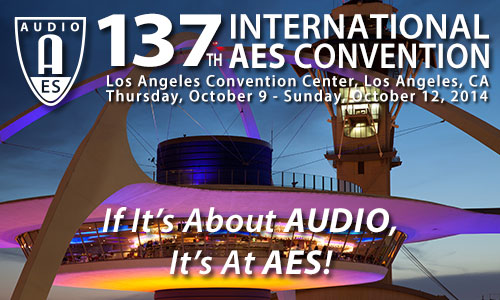
AES Los Angeles 2014
Paper Session P12
P12 - Transducers—Part 3
Saturday, October 11, 9:00 am — 12:00 pm (Room 308 AB)
Chair:
Robert-Eric Gaskell, McGill University - Montreal, QC, Canada; GKL Audio Inc. - Montreal, QC, Canada
P12-1 Compensation of the Flux Modulation Distortion Using an Additional Coil in a Loudspeaker Unit—Niccolò Antonello, Technical University of Denmark - Kgs. Lyngby, Denmark; KU Leuven - Leuven, Belgium; Finn Agerkvist, Technical University of Denmark - Kgs. Lyngby, Denmark
Flux modulation is one of the main causes of distortion in electrodynamic loudspeaker units. A new compensation technique that eliminates this type of non-linearity using an additional compensation coil in the speaker unit is presented. An equivalent circuit model of the device including the compensation coil is derived. The compensation technique consists on feeding the compensation coil and voice coil with filtered versions of the wanted audio signal. Simulations show that a significant reduction in flux modulation distortion can be achieved with this technique. A simple magnetic circuit has been constructed to test the method on a real device, and the measurements show the method works, also when eddy currents are present.
Convention Paper 9160 (Purchase now)
P12-2 Physical Requirements of New Acoustic Transducers to Replace Existing Moving-Coil Loudspeakers—Gyeong-Tae Lee, Samsung Electronics - Suwon-si, Gyeonggi-do, Korea; Jong-Bae Kim, Samsung Electronics - Suwon-si, Gyeonggi-do, Korea; Dong-Hyun Jung, Samsung Electronics - Suwon-si, Gyeonggi-do, Korea
New types of acoustic transducers have recently emerged as a possible alternative to moving-coil loudspeakers. However, they have not met the performance for commercialization enough to replace existing loudspeakers. In this paper to identify the requirements for high performance, we derived an analytical model of a moving-coil loudspeaker based on physical acoustics and electroacoustics, and evaluated the simulated results of the model in terms of acoustic performance. Finally, we discussed the physical requirements of new acoustic transducers from the perspective of bass performance, tonal balance, decay time, and spatial directivity and then made some suggestions.
Convention Paper 9161 (Purchase now)
P12-3 Nonlinear Flux Modulation Effects in Moving Coil Transducers—Felix Kochendörfer, JBL/Harman Professional - Northridge, CA USA; Alexander Voishvillo, JBL/Harman Professional - Northridge, CA, USA
Adverse effects in transducer motors produced by the nonlinear force factor on performance of loudspeakers are well understood. Nonlinear effects produced by dependence of the voice coil inductance and resistance on the coil’s position and on the current are less obvious. Previous work of the authors showed the nonlinear behavior of the voice coil inductive component presented as a function of the voice coil position, which was obtained by FEA simulation tools. This work is an attempt to obtain variation of the aforementioned parameters experimentally as functions of the voice coil position, current, and frequency.
Convention Paper 9162 (Purchase now)
P12-4 Design and Construction of a Circular AMT Speaker of 360° Radiation—Rodrigo Fernández Arcani, Universidad Nacional de Tres de Febrero - Buenos Aires, Argentina; Alejandro Sánchez Caparrós, Universidad Nacional de Tres de Febrero - Buenos Aires, Argentina
Among the electro-mechano-acoustical dynamic transducers there is one whose operating principle is not widely publicized. This transducer is known as Air Motion Transformer (AMT). Using this operation principle, a prototype of an AMT transducer type was designed and built with the particularity of making a cylindrical diaphragm. The behavior of the prototype was assessed and noted that it achieves a 360 degree of quasi uniform high frequency sound pressure level radiation in the horizontal plane. In order to improve the efficiency, several configurations are proposed.
Convention Paper 9163 (Purchase now)
P12-5 Identification Compression Driver Parameters Based on a Concept of Diaphragm’s Frequency-Dependent Area—Alexander Voishvillo, JBL/Harman Professional - Northridge, CA, USA
In the previous work, matrix analysis was applied the derivation of the transfer matrix of a compression driver’s diaphragm. Its mechanical impedance consisted of lumped parameters and a part corresponding to the high-frequency breakups. In the current work the mechanical impedance is based on lumped parameters whereas the area of the diaphragm is presented as a function of frequency. The transfer function of compression driver is derived from the overall matrix that includes the frequency-dependent area of the diaphragm. The area is included in the transformation matrix that links the mechanical and acoustical parts. By equating the measured SPL for a given input voltage to SPL derived from the model, the expression for the frequency-dependent area of the diaphragm can be derived. This information is used in modeling and design of different drivers using the identified diaphragm.
Convention Paper 9164 (Purchase now)
P12-6 A General Approach for the Acoustic Design of Compression Drivers with "Narrow" Channels and Rigid Diaphragms—Jack Oclee-Brown, GP Acoustics (UK) Ltd. - Maidstone, UK
A generalized approach to determining the position and size of "narrow" phase-plug channels is presented that is applicable to compression drivers with radiating diaphragms of arbitrary geometry. In addition, it is demonstrated that by carefully shaping the compression cavity according to the diaphragm motion then optimal behavior results. FEM computed examples are presented demonstrating the method for the case of a conical diaphragm geometry.
Convention Paper 9165 (Purchase now)
